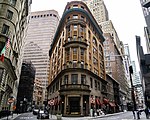Modern Language Association

The Modern Language Association of America, often referred to as the Modern Language Association (MLA), is the principal professional association in the United States for scholars of language and literature. The MLA aims to "strengthen the study and teaching of language and literature". The organization includes over 25,000 members in 100 countries, primarily academic scholars, professors, and graduate students who study or teach language and literature, including English, other modern languages, and comparative literature. Although founded in the United States, with offices in New York City, the MLA's membership, concerns, reputation, and influence are international in scope.
Excerpt from the Wikipedia article Modern Language Association (License: CC BY-SA 3.0, Authors, Images).Modern Language Association
Broad Street, New York Manhattan
Geographical coordinates (GPS) Address Website Nearby Places Show on map
Geographical coordinates (GPS)
| Latitude | Longitude |
|---|---|
| N 40.704 ° | E -74.011222222222 ° |
Address
85 Broad Street
Broad Street 85
10004 New York, Manhattan
New York, United States
Open on Google Maps









